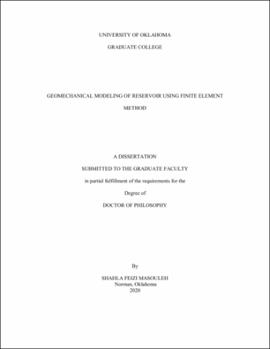| dc.description.abstract | The importance of refracturing horizontal wells in low permeability reservoirs is well recognized in the oil and gas industry. As a result of production from a propped open fracture, the stress changes in the reservoir. However, the stress change is anisotropic. This change in stresses near the producing horizontal well will act as a sink for infill well fractures and they tend to propagate towards the primary well, resulting in communications between producing and infill wells or so-called “frac-hits”. Previous studies have shown the effect of stress reorientation on the refracturing of vertical and horizontal wells. By figuring out the extent and timing of stress reorientation, the potential increase in well production after re-fracturing can be evaluated.
Coupled processes between matrix deformation and fluid flow are very important for predicting reservoir behavior and pore pressure evolution. Hydrocarbon production causes significant changes in pore pressure and stress in the reservoir. In this work, a coupled flow and geomechanics model was developed to capture changes of stress in magnitude and orientation during reservoir depletion. The simulator is based on the finite element method. The developed model is used to predict refracturing performance and help with planning infill wells.
As reservoirs usually contain more than one phase, it’s important to consider all the phases in geomechanical calculations.
Although sequentially coupled multiphase flow and geomechanics simulators have been developed and applied to describe multiphase flow in deformable porous media, they have limitations in modeling fractures and heterogeneous reservoirs.
Saturation weighted average pore pressure is commonly used in geomechanical calculations of two-phase flow; However, “equivalent pore pressure” is used in this work since capillary pressure is not negligible in the cases considered, and using average pressure may lead to numerical errors.
To our knowledge, the fully coupling of multiphase flow and geomechanics to study refrac jobs has not been studied before and previous studies have limitations on time step size and mesh type, uses average pore pressure instead of equivalent pore pressure, and ignores capillary pressure in the case studies.
The developed model was applied to analyze a waterflooding problem in homogeneous domain. Time-dependent field variables such as pressure distribution, saturation profile, displacements, and reservoir stresses were computed as water was injected and produced from the reservoir.
The present model is used to simulate the case of production from a fracture in a 3D reservoir. A comparative analysis of stresses, pore pressure, cumulative production, and rotation of principal stresses between single-phase and two-phase analysis is performed to investigate the impact of including multiphase flow in the design of fracturing operations.
The results show that the diffusion front travels farther into a reservoir in the case of single-phase flow due to the impact of relative permeability in multiphase flow. This causes the isotropic point to be at a greater distance from the well in a single flow model and can have an impact on the design of refrac jobs.
The new numerical poroelastic solution provides more realistic estimates for the time-dependent stress and pore pressure distribution around fractures thus allowing the production engineer to more accurately design refrac jobs and avoid frac hits. | en_US |
